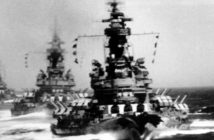On Sept. 26, 1931 – First Lady Lou Hoover lays the keel of the US Navy’s first purpose-built aircraft carrier, the USS Ranger (CV-4), at Newport News Shipbuilding and Drydock Co., Newport News, Va. At the time, the Navy had three aircraft carriers, one a converted collier, the USS Langley (CV-1), and two converted battlecruisers, the USS Lexington (CV-2) and the USS Saratoga (CV-3).
At nearly 15,000 tons and 770 feet long, the Ranger was an evolutionary step in the design of US aircraft carriers, shaping the succeeding Yorktown-class and the iconic Essex-class that became the workhorse of US carrier force until the early 1970s.
The size of the $15 million Ranger was dictated by the Washington Naval Treaty that limited the tonnage of each type of capital ship in signatory nation’s navies. The treaty forced the conversation of the Lexington and Saratoga from battlecruisers to aircraft carriers, but the ships were so massive that they left 69,000 tons for new aircraft carriers. The Navy hoped it could build five 14,000-ton ships.
The Ranger was originally built as a flush-deck ship without an island — like the Langley — and with three folding smokestacks on each side of the after part of the flight deck. After completion, she was modified with a small island .
The Ranger, however, was deemed too slow for the Pacific and served during World War II in the Atlantic as a combat carrier, aircraft ferry and training ship. She was decommissioned at the end of the war and scrapped in 1947.




